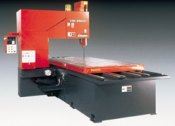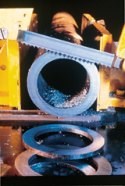Switch To Wide-Set Carbide Blade Enhances Bandsaw Blade Life And Productivity
M&M Cut-O-Matic (Downey, California) slices custom blanks from various grades of tough-to-cut alloys and super alloys including aircraft-grade aluminum, stainless steel, Inconel and titanium. The company, which operates 5 to 6 days per week (16 to 19 hours per day), makes specialized cutoffs of large, thick workpieces utilizing two VM 2500 plate saws.
M&M Cut-O-Matic (Downey, California) slices custom blanks from various grades of tough-to-cut alloys and super alloys including aircraft-grade aluminum, stainless steel, Inconel and titanium. The company, which operates 5 to 6 days per week (16 to 19 hours per day), makes specialized cutoffs of large, thick workpieces utilizing two VM 2500 plate saws. Unlike standard bandsaws, plate saws hold the blade stationary while workpieces move against it. "Plate saws are expensive, but they justify their extra cost with better cutting control than standard bandsaws," says Steve Martin, vice president of M&M Cut-O-Matic. One plate saw cuts plates up to 42 inches wide, while the other cuts plates up to 20 inches wide. Bar stock is flame cut prior to bandsawing to create a pilot groove, thereby improving accuracy of the sawblade teeth on the entrance cut.
According to Mr. Martin, a very common side effect of heat treating tough-to-cut alloys is excess slag buildup.
The slag forms on the ends of workpieces and then hardens, which ruins blades and slows production. "Our conventional double-set carbide blades just couldn't penetrate the plates due to all the slag buildup," explains Mr. Martin. "Sometimes we had to stop, grind the part or hit it with a hammer to knock off the excess slag." Additionally, tough-to-cut alloys themselves can put tremendous stresses on conventional sawblade teeth, causing them to chip or break at the brazement. "As a result, we would have to stop for blade changes, which took 10 minutes each time, and that was affecting our productivity," says Mr. Martin.
Another cause for concern was that M&M's conventional carbide blades just weren't cutting fast enough to make up for the lost productivity during blade changes. They were running at cutting speeds of 80 sfm during blade break-in and at 90 to 100 sfm at full cutting speeds.
Faced with mounting problems, M&M searched for an appropriate solution that would increase blade life, bandsaw productivity and blade cutting speeds on its plate saw jobs.
As a first step, M&M contacted its distributor, Saw Service Of America, to see if it knew of a cost-effective solution to the bandsawing problems. The distributor suggested Bahco Tools, Inc. (Scranton, Pennsylvania), a full line carbide bandsaw blade company. "We heard about the reputation and expertise of Bahco Tools in the field, so we gave them a call," says Mr. Martin. "A few days later we met with Bahco's technical experts. They brought with them several alternative carbide sawblades."
M&M engineers and Bahco Tool's technical experts worked hand in hand to find the right sawblade for the company's plate saws. They tried a Sandvik 3868 Triple-Set Xtra carbide-tipped coarse two-pitch blade, which was specifically designed to saw through large, thick, tough-to-cut bar stock. M&M tested the 3868 blade in conjunction with its conventional carbide blades over an 8-month period. After just 6 months, M&M was convinced that the 3868 blade could perform better than its conventional carbides and at higher cutting speeds, so M&M standardized the 3868 on both VM 2500 plate saws.
Key to the 3868 blade's success is its Triple-Set combination tooth profile. It has a high, unset raker tooth with chamfered edges located dead center and two lower unchamfered teeth set left and right. The blade's tooth geometry allows for freer cutting and improved swarf clearance. Its deep gullets also help to minimize clogging and distribute feed forces more evenly among fewer teeth, thus maximizing penetration into workpieces. Additionally, the blade produces three distinct chips with significantly lower cutting forces than conventional carbide blades.
M&M's switch to the 3868 blade met all its expectations. The company cut bandsawing costs 30 to 35 percent on average by reducing the high frequency of blade changes on typical part runs. It can now run its machines 3 to 4 days straight without changing blades-getting 40 percent more blade life. Additionally, the carbide-tipped blade can be run at more than double the cutting speeds of its earlier carbide counterparts. As a result, M&M increased parts productivity on average by 40 percent on all its plate saw jobs. It also became a more competitive cutoff service and can now handle quoted customer turnaround times more efficiently.
M&M still utilizes conventional double-set carbide blades on its other bandsaw machines, which are designed to cut smaller workpieces. However, due to the success of the 3868 blade, M&M is working with Bahco to design a ½-inch pitch 3868 blade for those bandsaw machines.
Read Next
The Cut Scene: The Finer Details of Large-Format Machining
Small details and features can have an outsized impact on large parts, such as Barbco’s collapsible utility drill head.
Read More3 Mistakes That Cause CNC Programs to Fail
Despite enhancements to manufacturing technology, there are still issues today that can cause programs to fail. These failures can cause lost time, scrapped parts, damaged machines and even injured operators.
Read More












.png;maxWidth=300;quality=90)









